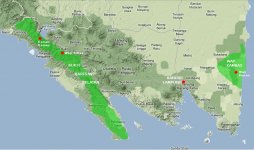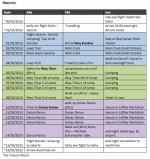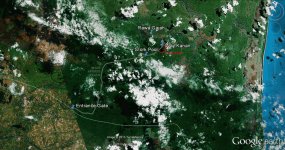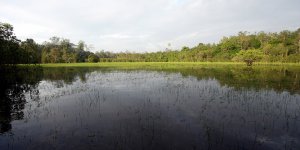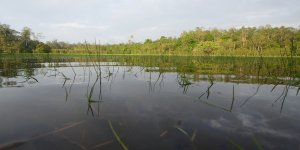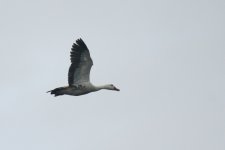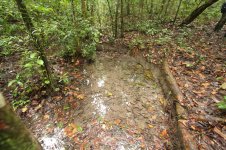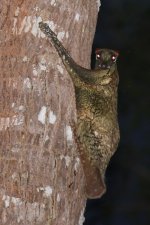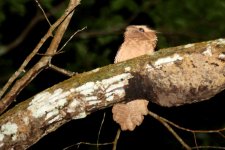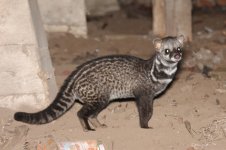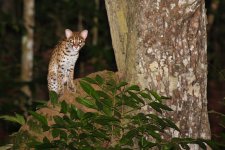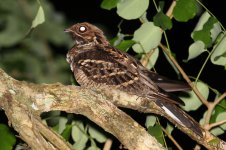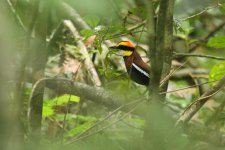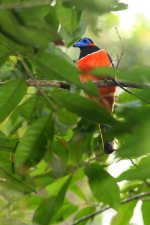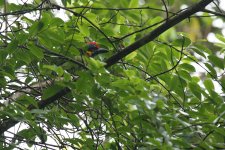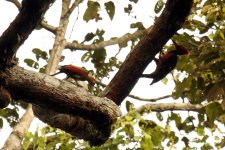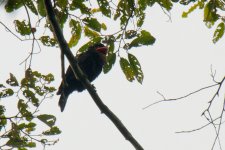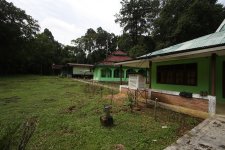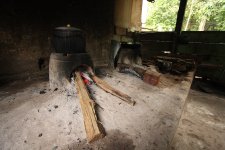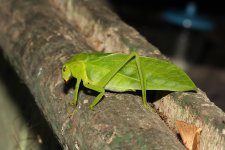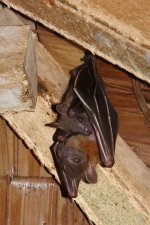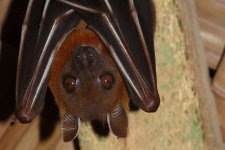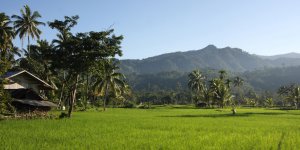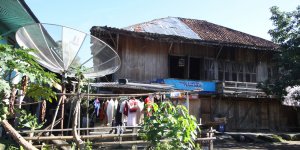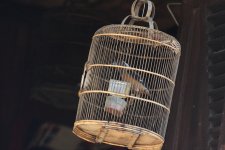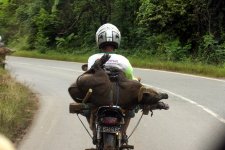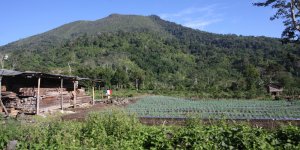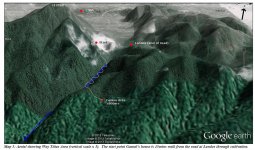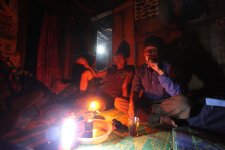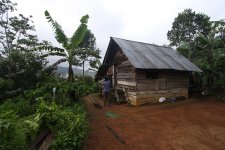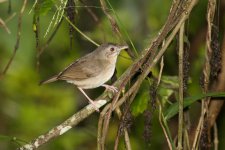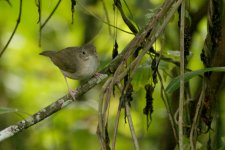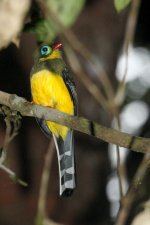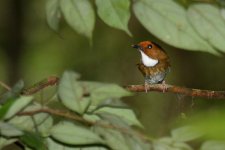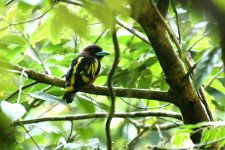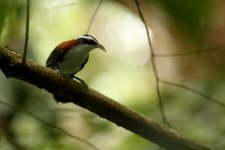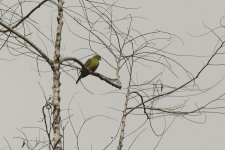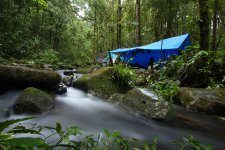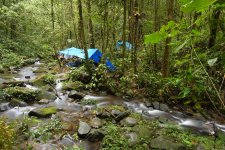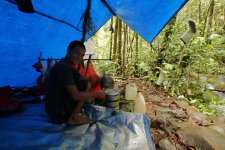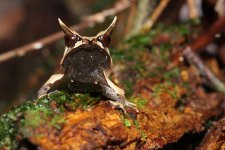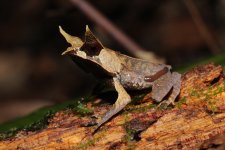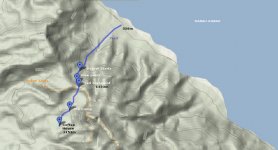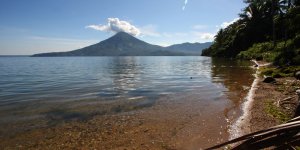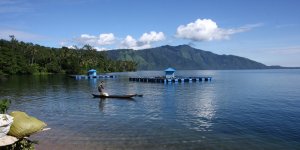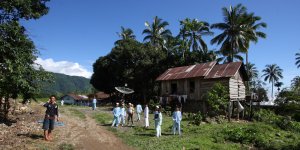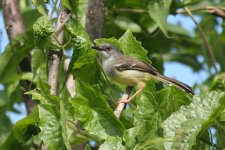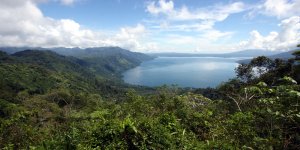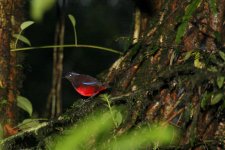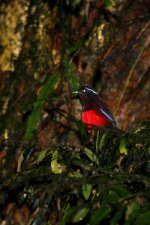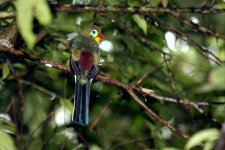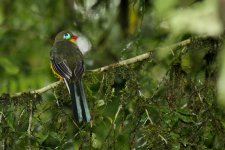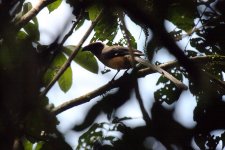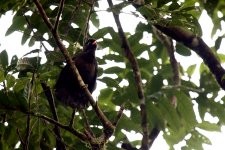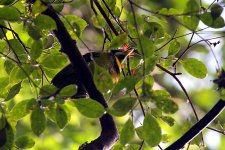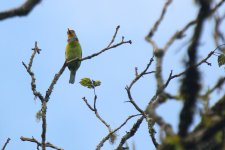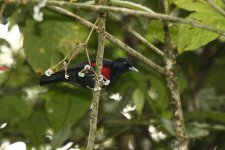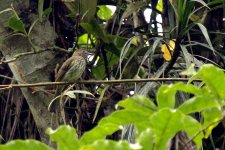SOUTHERN SUMATRA FEBRUARY 2013
Introduction
Christmas Eve 2012 and I received an email from Martin Gottschling regarding a trip he was putting together in February to look for a few of Sumatra’s montane forest endemics, but notably the two Pittas; Graceful Pitta and Schneider’s Pitta. Given the most prolific recent location for the latter has been at Danau Ranau in the southern national park of Bukit Barisan Selatan, it also seemed sensible to allocate part of the trip to make the pilgrimage to the relatively recently discovered Sumatran Ground Cuckoo site at Way Titias that is also part of the National Park. It would have been rude not to.
Martin had already convinced his birding pal in Germany Holger Lauruschkus to join him and was after another Pitta ‘enthusiast’ to make a team of three for the trip to share logistical costs and birding experiences. I had first met Martin on the Azores a couple of years previous, so he was well aware of my fondness for the world’s Pittas; and Holger too has birded around parts of SE Asia with Martin, so the writing was on the wall for a potentially exciting whistle stop tour of some of Southern Sumatra’s highlights.
Logistics
Martin sorted all logistics with a friend and contact he has in Jakarta, an Indonesian birder named Ari, who he first met whilst working at the bird observatory on Heligoland a few years previous. The logistics basically followed that prescribed by recent trip reports notably the one by Ashley Banwell and John Gregory – using a middleman to contact the ground agents for two sites; Way Titias and Danau Ranau, who then set up the itinerary at these sites. They used a different fixer to us, but the details are otherwise roughly the same:
A growing number of people have now braved the rediscovered Sumatran Ground Cuckoo site at Way Titias in Bukit Barisan Selatan NP and have shared their experiences, and these formed background and pre-trip preparation. The following were consulted on top of the report mentioned above:
As well as visiting Bukit Barisan Selatan National Park we had a few nights in the Sumatran lowland site at Way Kambas National Park. There is a lot of information on this site, and the following accounts amongst others were read in preparation:
The only field guide we took were copies of Mackinnon & Phillipps (1993) A Field Guide to the Birds of Borneo, Sumatra, Java and Bali. This book is now getting quite out of date with the many splits and proposed splits of recent years – particularly of endemic forms. The gradual increase in birding in the region is providing more knowledge of avifauna, with for example, the well documented rediscovery of the Ground Cuckoo, plus other interesting snippets on target species like Graceful Pitta known from more recent times than 1918, and Sumatran Cochoa now known from more than the “…four specimens, all males, collected on Singgalang & Kerinci…” as stated in the book. There is also the odd mistake and the altitudinal ranges for a number of species are out of date. Having said all that it is however still a usable and useful guide, with lots of information present, and will continue to be the staple field guide until updated. It is also quite interesting to see what has changed and the advances in collective knowledge over just the last 20 years.
A Note on Timing
Most birders take the more sensible option of visiting Sumatra during the main dry season period of late summer. A few have selected peak rainy season for the south (Noc/Dec-Jan/Feb), and others have visited towards the end of the peak rains in April. It is said that the climate is not particularly stable here and rain can be expected during any season, especially in the mountains. We encountered rain virtually daily, mostly in the afternoon and on a couple of occasions it curtailed all birding activities in the afternoon period and into the evening period. Even if not raining the threat of rain in the afternoons seemed enough to ensure the forests remained fairly quiet and bird activity low at that time of day. On a couple of days in Danau Ranau relatively strong and cold winds from the west were also a feature and this affected key morning birding periods; particularly the frequency of encounters with bird waves.
We selected February as a birding friend of Martin’s had visited Danau Ranau in Feb 2012 and his experience was that both endemic Pitta species were actively defending territories during this period (and are thus more likely to be encountered). Although it would be nice to travel peak birding season, it is not a good option work wise for the three of us, so a favourable report from winter time was all that was needed for us to attempt the trip during the rains.
Locations
The Map attached below is an illustrative map showing the general locations of National Parks and locations visited within them. The two main areas we visited were Bukit Barisan Selatan National Park and Way Kambas National Park.
Itinerary
The second attachment below is a table outlining the itinerary for the trip.
Costs
The currency in Indonesia is the Indonesian Rupiah (IDR) at the time of visit the exchange rate was roughly £1 = IDR15,000, and my credit card charged me £66.32 for IDR1,000,000
I booked my air tickets a couple of weeks prior to departure. The long haul was with Qatar Airways and cost £582 return Heathrow to Jakarta with a layover in Doha. The internal flight was booked on the Garuda Indonesia website and cost £134 return Jakarta to Bandar Lampung (note current UK FCO advice on the various Indonesian airlines). A Visa is necessary in Indonesia for UK citizens, which can be obtained on arrival and is valid for 30 days ($25 US). An airport tax of IDR150,000 is payable on leaving the country.
The trip to the Bukit Barisan Selatan NP sites (Way Titias and Danau Ranau) was a fixed charge that covered all overheads (from pick up in Way Kambas to drop off at airport in Bandar Lampung). This is probably not the cheapest way of doing it, but left no uncertainties, which was helpful on such a tight trip time wise. The cost for three people for 10 days was IDR27,734,000 (just over £600 pp) –This covered the following:
[*We called Gamal ‘Kamal’ as that is how he pronounced his name, but from correspondence with Nick Brickle he mentions that it is spelt with a ‘G’ and the pronunciation is guttural hence the inflection.]
We managed to empty the ATM of cash at Bandar Lampung airport (be aware it’s a very small airport!), as Toni met us from our flight and wanted full upfront payment in IDR, and that was after maxing the daily limit of our credit cards in Jakarta the night before, so we only needed half the cash from the BL ATM! Didn’t notice any cash converters here, but there were plenty at Jakarta airport.
It may also be useful to future visitors if I also outline the other main charges we encountered in Way Kambas, which is not the cheapest park in this part of the world as official rules state you must be accompanied by a guard/ranger on all visits into the field. The charges between three people were however acceptable and it is good to know you are helping local jobs in conservation to some extent. The costs below are per group/activity and not individual costs:
Hotel in Bandar Lampung opposite the Airport (Hotel Modjopahet) – IDR125,000 per twin room economy (and my room was pretty ropey). The AC rooms were full, maybe they were of a better standard.
Hotel in Jakarta – Amaris – cIDR200,000 twin room, aircon, free shuttle to airport, and Man United vs Soton on the tv, but I only got to enjoy the room for c5hrs.
Remainder of Trip Report
Highlights of the trip from each location to follow in the form of an introduction to each area visited and our highlights, followed by a few annotated photos of some of these highlights.
Introduction
Christmas Eve 2012 and I received an email from Martin Gottschling regarding a trip he was putting together in February to look for a few of Sumatra’s montane forest endemics, but notably the two Pittas; Graceful Pitta and Schneider’s Pitta. Given the most prolific recent location for the latter has been at Danau Ranau in the southern national park of Bukit Barisan Selatan, it also seemed sensible to allocate part of the trip to make the pilgrimage to the relatively recently discovered Sumatran Ground Cuckoo site at Way Titias that is also part of the National Park. It would have been rude not to.
Martin had already convinced his birding pal in Germany Holger Lauruschkus to join him and was after another Pitta ‘enthusiast’ to make a team of three for the trip to share logistical costs and birding experiences. I had first met Martin on the Azores a couple of years previous, so he was well aware of my fondness for the world’s Pittas; and Holger too has birded around parts of SE Asia with Martin, so the writing was on the wall for a potentially exciting whistle stop tour of some of Southern Sumatra’s highlights.
Logistics
Martin sorted all logistics with a friend and contact he has in Jakarta, an Indonesian birder named Ari, who he first met whilst working at the bird observatory on Heligoland a few years previous. The logistics basically followed that prescribed by recent trip reports notably the one by Ashley Banwell and John Gregory – using a middleman to contact the ground agents for two sites; Way Titias and Danau Ranau, who then set up the itinerary at these sites. They used a different fixer to us, but the details are otherwise roughly the same:
- Ashley Banwell & John Gregory (2007) “Little Known Southern Sumatra” – this report distils detailed information on who, how, where and what to expect, and covers everything in as much detail as is necessary to follow in their footsteps so is recommended as the starting point for any future visitors to this area of Bukit Barisan Selatan NP.
A growing number of people have now braved the rediscovered Sumatran Ground Cuckoo site at Way Titias in Bukit Barisan Selatan NP and have shared their experiences, and these formed background and pre-trip preparation. The following were consulted on top of the report mentioned above:
- Chris Gooddie (2010) “The Jewel Hunter” Wildguides (recommended reading - there is whole chapter on Sumatra – ‘The Toktor will see you now’ […but not necessarily you it!]. I re-read this chapter a number of times prior to the trip, a nice introduction on what to expect, to compliment the logistical details in the Ashley Banwell & John Gregory report. Toktor by the way is the Indonesian name for the Ground-cuckoo;
- Wendy Newman (2009) Sumatra 1-22 September 2009 another detailed account;
- Reports and general site information on the Birding Indonesia website: http://burung-nusantara.org/ (including links here directly to the ground team contacts in Bukit Barisan Selatan if your Indonesian communication skills are upto the job of cutting out the middle man and organising with them directly over the phone - they speak no English);
- Martin also had information from various email exchanges on the Oriental Birding email group, primarily about the Ground Cuckoo site ‘Way Titias’, but also the nearby site ‘Danau Ranau’ where Schneider’s Pitta was becoming a regular fixture. This included emails from Nick Brickle (who originally went with the local hunter Gamal to locate the Ground Cuckoo and become the first non-local to see one in the wild), birdforum's DMW, Chris Gooddie and others.
As well as visiting Bukit Barisan Selatan National Park we had a few nights in the Sumatran lowland site at Way Kambas National Park. There is a lot of information on this site, and the following accounts amongst others were read in preparation:
- János Oláh & Attila Simay “Way Kambas National Park, Sumatra: The Best Asian Night-birding” BirdingAsia 8 (2007):39-44
- Paul Jepson ed. (2004) “Birding Indonesia: A Birdwatchers Guide to the Worlds Largest Archipelago” Periplus Action Guides
- Oscar Campbell (2012)” Sumatra 2012” Surfbirds Trip Reports
- Richard Webb (2012) “Sumatra: Way Kambas National Park 27 May – 4 June 2012” Mammalwatching.com
- A number of older trip reports were useful, including for Gunung Kerinci and Tapan Road as to the montane endemics generally.
The only field guide we took were copies of Mackinnon & Phillipps (1993) A Field Guide to the Birds of Borneo, Sumatra, Java and Bali. This book is now getting quite out of date with the many splits and proposed splits of recent years – particularly of endemic forms. The gradual increase in birding in the region is providing more knowledge of avifauna, with for example, the well documented rediscovery of the Ground Cuckoo, plus other interesting snippets on target species like Graceful Pitta known from more recent times than 1918, and Sumatran Cochoa now known from more than the “…four specimens, all males, collected on Singgalang & Kerinci…” as stated in the book. There is also the odd mistake and the altitudinal ranges for a number of species are out of date. Having said all that it is however still a usable and useful guide, with lots of information present, and will continue to be the staple field guide until updated. It is also quite interesting to see what has changed and the advances in collective knowledge over just the last 20 years.
A Note on Timing
Most birders take the more sensible option of visiting Sumatra during the main dry season period of late summer. A few have selected peak rainy season for the south (Noc/Dec-Jan/Feb), and others have visited towards the end of the peak rains in April. It is said that the climate is not particularly stable here and rain can be expected during any season, especially in the mountains. We encountered rain virtually daily, mostly in the afternoon and on a couple of occasions it curtailed all birding activities in the afternoon period and into the evening period. Even if not raining the threat of rain in the afternoons seemed enough to ensure the forests remained fairly quiet and bird activity low at that time of day. On a couple of days in Danau Ranau relatively strong and cold winds from the west were also a feature and this affected key morning birding periods; particularly the frequency of encounters with bird waves.
We selected February as a birding friend of Martin’s had visited Danau Ranau in Feb 2012 and his experience was that both endemic Pitta species were actively defending territories during this period (and are thus more likely to be encountered). Although it would be nice to travel peak birding season, it is not a good option work wise for the three of us, so a favourable report from winter time was all that was needed for us to attempt the trip during the rains.
Locations
The Map attached below is an illustrative map showing the general locations of National Parks and locations visited within them. The two main areas we visited were Bukit Barisan Selatan National Park and Way Kambas National Park.
Itinerary
The second attachment below is a table outlining the itinerary for the trip.
Costs
The currency in Indonesia is the Indonesian Rupiah (IDR) at the time of visit the exchange rate was roughly £1 = IDR15,000, and my credit card charged me £66.32 for IDR1,000,000
I booked my air tickets a couple of weeks prior to departure. The long haul was with Qatar Airways and cost £582 return Heathrow to Jakarta with a layover in Doha. The internal flight was booked on the Garuda Indonesia website and cost £134 return Jakarta to Bandar Lampung (note current UK FCO advice on the various Indonesian airlines). A Visa is necessary in Indonesia for UK citizens, which can be obtained on arrival and is valid for 30 days ($25 US). An airport tax of IDR150,000 is payable on leaving the country.
The trip to the Bukit Barisan Selatan NP sites (Way Titias and Danau Ranau) was a fixed charge that covered all overheads (from pick up in Way Kambas to drop off at airport in Bandar Lampung). This is probably not the cheapest way of doing it, but left no uncertainties, which was helpful on such a tight trip time wise. The cost for three people for 10 days was IDR27,734,000 (just over £600 pp) –This covered the following:
- All food and accommodation (including hotel in Liwa (Permata Hotel) but not in Bandar Lampung);
- Use of two field assistants, Gamal* (Mr Toktor himself) – ex-hunter turned bird guide who has an excellent knowledge of the two sites and superb hearing and eyesight for the key species at least, and Toni – the Chef and overall general logistics man;
- Porters for our food, tents and overnight bags (they left us once set up in the forest);
- Charges for NP fees (we had a NP ranger accompany us for the duration on both trips, although they both mostly stayed at camp with Toni);
- Minibus from Way Kambas to Way Titias (c7hrs), Way Titias to Danau Ranau (c1.5hrs) and Danau Ranau to Bandar Lampung (c5hrs)
[*We called Gamal ‘Kamal’ as that is how he pronounced his name, but from correspondence with Nick Brickle he mentions that it is spelt with a ‘G’ and the pronunciation is guttural hence the inflection.]
We managed to empty the ATM of cash at Bandar Lampung airport (be aware it’s a very small airport!), as Toni met us from our flight and wanted full upfront payment in IDR, and that was after maxing the daily limit of our credit cards in Jakarta the night before, so we only needed half the cash from the BL ATM! Didn’t notice any cash converters here, but there were plenty at Jakarta airport.
It may also be useful to future visitors if I also outline the other main charges we encountered in Way Kambas, which is not the cheapest park in this part of the world as official rules state you must be accompanied by a guard/ranger on all visits into the field. The charges between three people were however acceptable and it is good to know you are helping local jobs in conservation to some extent. The costs below are per group/activity and not individual costs:
- Half day trip into park per group with ranger/guide = IDR300,000
- Boat Trip to Rawa Gajah Swamp IDR500,000
- Overnight basic accommodation at Way Kanan Station 3nights = IDR900,000 for room
- Food, all meals and drinks (tea, coffee, mineral water) three days three people = IDR480,000. Despite offering to go shopping for us, we elected to survive on what the rangers had in stock (Mie (Noodles) & Nasi (Rice) Goreng (fried)). It is usually recommended you bring your own food with you if staying at Way Kanan field station and the rangers will cook it for you;
- We were recommended to pay the rangers a tip for any night birding excursions beyond what would be considered reasonable for a standard half day outing;
- Taxi from BL airport to Way Kambas = IDR660,000
Hotel in Bandar Lampung opposite the Airport (Hotel Modjopahet) – IDR125,000 per twin room economy (and my room was pretty ropey). The AC rooms were full, maybe they were of a better standard.
Hotel in Jakarta – Amaris – cIDR200,000 twin room, aircon, free shuttle to airport, and Man United vs Soton on the tv, but I only got to enjoy the room for c5hrs.
Remainder of Trip Report
Highlights of the trip from each location to follow in the form of an introduction to each area visited and our highlights, followed by a few annotated photos of some of these highlights.




